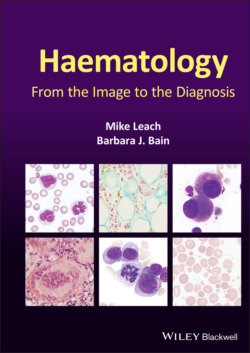Читать книгу Haematology - Barbara J. Bain, Irene Roberts - Страница 10
Оглавление1 Anaplastic large cell lymphoma with haemophagocytic syndrome
A 50‐year‐old man from another health board was transferred to a local hospital for a surgical biopsy of a mediastinal lymph node. He had presented 6 weeks previously with fever, sweats and weight loss. No infective or neoplastic aetiology had been identified. He had progressive pancytopenia and hyperferritinaemia and a diagnosis of idiopathic haemophagocytic syndrome had been considered. He had already been treated at the base hospital with corticosteroids and etoposide. CT imaging, however, had shown abnormal mediastinal lymph nodes, which would not have been accessible by percutaneous needle biopsy.
On arrival at the local cardiothoracic unit he was clearly unwell. The full blood count showed Hb 90 g/l, WBC 2.5 × 109/l, neutrophils 1.5 × 109/l and platelets 25 × 109/l. The coagulation screen showed PT 18 s, APTT 45 s, TT 18 s, fibrinogen 1.4 g/l and D dimer 5500 ng/ml (NR <230). Serum ferritin was >10 000 μg/l. The anaesthetic team phoned to ask for advice regarding management of the coagulopathy prior to surgery. The blood film showed rouleaux and was leucoerythroblastic with a few toxic granulated neutrophils but no neoplastic cell population was evident. We decided to cancel the surgery, review the imaging and perform a bone marrow aspirate and trephine biopsy. A CT scan showed definitely pathological mediastinal lymph nodes. The bone marrow aspirate showed a population of very large lymphoid cells with round or ovoid nuclei, indistinct nucleoli and partially condensed nuclear chromatin without cytoplasmic granules (top images). The cytoplasm of these cells showed prominent vacuolation, often concentrated in apparent pseudopodia (top images). In addition, there was a substantial population of macrophages showing haemophagocytosis, particularly of red cells and their precursors (all images above ×100 objective). The clinical, laboratory and morphological findings were in keeping with a haemophagocytic syndrome. Flow cytometry on the large cell population in the marrow aspirate showed these cells to express CD45, CD2, CD3, CD4 and CD30. No myeloid or B‐lineage antigens were expressed. The bone marrow trephine biopsy sections were also abnormal, showing prominent macrophages displaying haemophagocytosis on H&E staining (below, left image) and CD68R (below, centre image, immunoperoxidase), whilst the large neoplastic cells were highlighted using CD30 (below, right, immunoperoxidase) (all images below ×50). Immunohistochemistry showed the large cells to be ALK negative. The diagnosis was now confirmed as ALK‐negative anaplastic large cell lymphoma. The patient was transferred back to his local hospital with a view to commencing CHOP chemotherapy but after one cycle of treatment he deteriorated further and sadly died.
Haemophagocytic syndrome is a rare constellation of clinicopathological features including fever, weight loss, sweats and organomegaly, together with laboratory abnormalities including cytopenias, hyperferritinaemia, hypertriglyceridaemia, coagulopathy and bone marrow haemophagocytosis. Interestingly, according to strict diagnostic criteria, and despite the name, demonstration of the latter is not absolutely essential. In adults the typical triggers for a confirmed haemophagocytic syndrome are infective or neoplastic. In adult patients a neoplastic cause is very likely and high‐grade T‐cell and NK‐cell neoplasms are the usual culprits. In paediatric practice there are a number of inherited immunodeficiency syndromes that strongly predispose to a haemophagocytic syndrome, but neoplastic and infective triggers similar to the above have also to be considered. It is absolutely essential to consider a neoplastic cause in adult patients; this focuses attention on looking for an underlying neoplasm with subsequent targeted treatment, in which case the haemophagocytic syndrome will gradually resolve.
MCQ
1 ALK‐negative anaplastic large cell lymphoma:Generally occurs at an older age than ALK‐positive casesHas a better prognosis than ALK‐positive anaplastic large cell lymphomaHas similar histological and immunophenotypic features to breast implant‐associated anaplastic large cell lymphomaIs usually associated with t(2;5)(p23.2‐23.1;q35.1)Usually presents with localised diseaseFor answers and discussion, see page 206.
